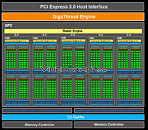Wednesday, February 12th 2014

GM107 Features 128 CUDA Cores Per Streaming Multiprocessor
NVIDIA's upcoming GM107 GPU, the first to be based on its next-generation "Maxwell" GPU architecture, reportedly features a different arrangement of CUDA cores and streaming multiprocessors to those typically associated with "Kepler," although the component hierarchy is similar. The chip reportedly features five streaming multiprocessors, highly integrated computation subunits of the GPU. NVIDIA is referring to these parts as "streaming multiprocessor (Maxwell)," or SMMs.
Further, each streaming multiprocessor features 128 CUDA cores, and not the 192 CUDA cores found in SMX units of "Kepler" GPUs. If true, GM107 features 640 CUDA cores, all of which will be enabled on the GeForce GTX 750 Ti. If NVIDIA is carving out the GTX 750 by disabling one of those streaming multiprocessors, its CUDA core count works out to be 512. NVIDIA will apparently build two GPUs on the existing 28 nm process, the GM107, and the smaller GM108; and three higher performing chips on the next-generation 20 nm process, the GM206, the GM204, and the GM200. The three, as you might have figured out, succeed the GK106, GK104, and GK110, respectively.
Source:
VideoCardz
Further, each streaming multiprocessor features 128 CUDA cores, and not the 192 CUDA cores found in SMX units of "Kepler" GPUs. If true, GM107 features 640 CUDA cores, all of which will be enabled on the GeForce GTX 750 Ti. If NVIDIA is carving out the GTX 750 by disabling one of those streaming multiprocessors, its CUDA core count works out to be 512. NVIDIA will apparently build two GPUs on the existing 28 nm process, the GM107, and the smaller GM108; and three higher performing chips on the next-generation 20 nm process, the GM206, the GM204, and the GM200. The three, as you might have figured out, succeed the GK106, GK104, and GK110, respectively.

42 Comments on GM107 Features 128 CUDA Cores Per Streaming Multiprocessor
Oh and GPUz was wrong :p
Balancing the components for efficiency gains, eliminating bottlenecks.
They are saying there are less SP/cudacores in each CU compute unit or SMM
Software yes... but not hardware.
They support some of the features, but they are not DX 11.1 or 11.2 compliant.
Efficiency gains is where maxwell is supposed to be dominating on.
Even the latest GTX 780 Ti is only 11 compliant
Perhaps, on the 18th, the conjecture will end? 6 more days. Have fun! I'm gonna wait and hopefully see some real tests, with real cards.
:D
dude.. i must admit it.. that you're very funny..
We have been inundated with titles using DX11.2 after all.
but maxwell is looking pretty week....
Supercalar Processing: www.anandtech.com/show/3809/nvidias-geforce-gtx-460-the-200-king/2
But seriously, it's a GX107 part, of course it's not going to set the world alight on pure performance alone, but it's how it reaches that performance that will be interesting, especially how it compares to Kepler on the same process will be rather telling.
Couple of things are interesting compared to Kepler : increased number of instructions per cycle, bigger cache and 15% larger transistor density on the same 28nm node.
GM107 = 2mb
GK107 = 256kb
GK110 = 1.5mb
Hawaii = 1mb
12mb of L2 cache on die soon... :respect:
8800 GTX/128 - HD 2900/320
GTX 285/240 - HD 4890/800
GTX 480/480 - HD 5870/1600
GTX 580/512 - HD 6970/1536
GTX 680/1536 - HD 7970/2048
GTX 780/2304-2880 - R9 290X/2816
Now both companies tied and Nvidia optimize their cores again. One day AMD will realize that something is not right with 10000 SP, 700 TDP, 199,9°C.